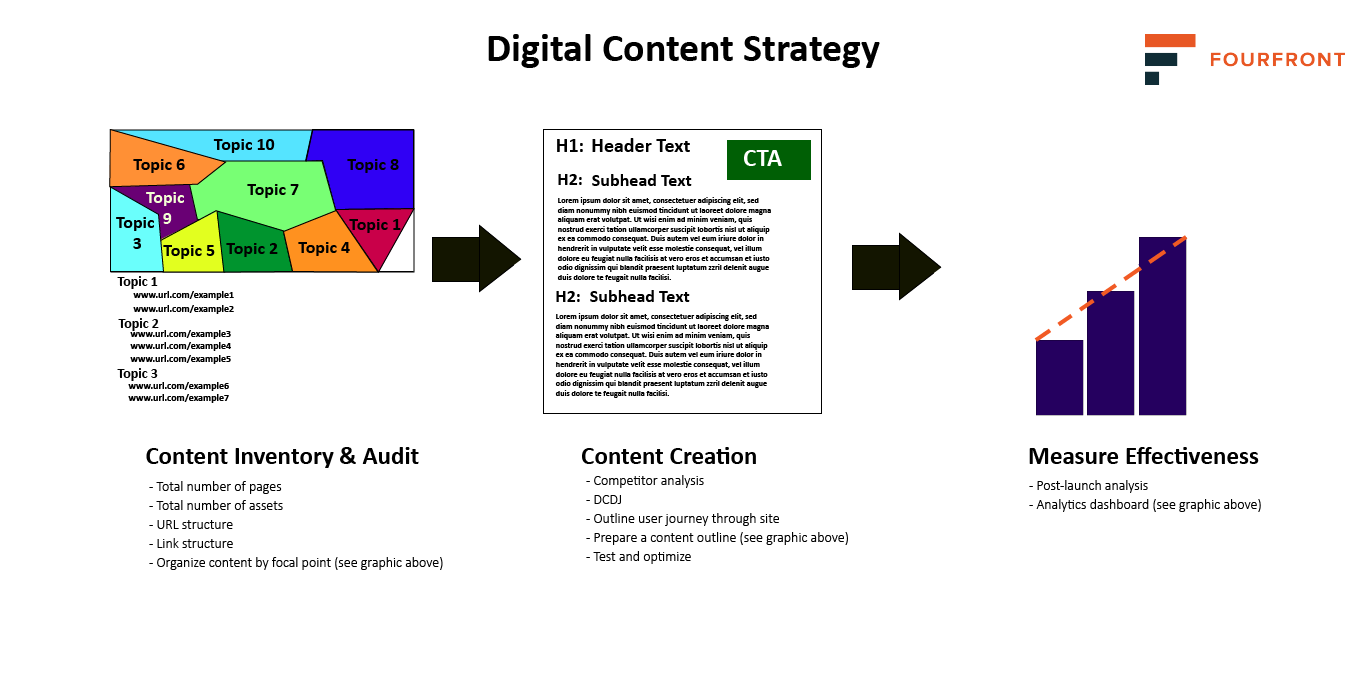A successful SEO strategy is one which puts content first. Productive content answers the users’ queries along their digital journey when their needs and search patterns are properly assessed. Google is sophisticated enough to know whether content is performing up to the standards of the user through behavior analytics. It’s a celebration-worthy achievement to rank on page one of the SERP, but in order to stay in that coveted position, your content needs to prove itself through SEO analytics such as short vs. long click, content gap fulfillment, and task completion success. A content-first, performance-driven model will inherently be best practice from an SEO perspective.
The following steps can get you started on your way to hosting productive content on your website. Content development can be broken down into 3 main steps. This plan will help guide your content development process by establishing a big-picture perspective from which all content can be viewed and placed in an actionable framework, new content can be created, content can be repurposed or deleted, and your focal points can be measured.
Step 1: Content Inventory & Audit
What is this?
The starting point for any content analysis needs to be a quantitative list of what is on your website and related data about these pages. From this quantitative content inventory, you can build both a quantitative and qualitative content audit which will provide decision support for your content revisions.
What are the key outcomes of the content inventory?
- How many pages does your website have?
- How many and what types of assets are on your website?
- Where are the pages hosted (domain) and located (URL)?
- What is the URL structure?
- What are the links into or from each page?
- What is the metadata for each page?
What are the key outcomes of the content audit?
- Organize content by focal points so you can measure specific KPIs.
- Organize content according to the DCDJ (Digital Consumer Decision Journey) to be sure the queries are being answered at each step of the user’s journey.
- Decide what keywords to target for each stage of each focal point.
- Sort/filter by content type, keyword relevancy, host and URL segment.
- Sort/filter by performance with number of pageviews, landings, time on page, and exits.
- Sort by keyword relevancy.
- Cluster by concepts.
Why is this necessary?
- This helps create a roadmap for each focal point. You will be identifying what matters most to your business and which content supports these goals.
-
It enables you to answer the following questions:
- What content do you need?
- What content is redundant?
- What content can be eliminated or moved due to poor performance? Are these pages performing badly due to the content or the placement?
- What content is outdated and needs to be refreshed?
- What content is most productive for discovery and why is this productive?
- What content can be repurposed and optimized?
- What content needs to be created?
Step 2: Content Creation
Once you have the inventory and audit analysis, you can prioritize focal points based on your business goals and objectives. The data from the inventory and audit will guide the content creation step. Conduct the following steps for each focal point:
- Conduct a competitor analysis to identify top landing pages, keywords, and concepts.
- Determine the set difference between your website and the websites of your top peer competitors. This helps define what assets are common and unique among your top competitors.
- Map out the Digital Customer Decision Journey (DCDJ), which identifies what content is needed to move users through the following stages: Introduction, Interest, Intent, and Conversion.
- Outline the journey through internal links which will take the user from the landing page then through navigation pages to deeper assets. Note where the calls-to-actions are along the way.
- Prepare a content outline for each page which includes concepts and keywords which are being targeted.
- Test and optimize the content before publishing to be sure the search engine is interpreting the keywords and concepts as intended.
Step 3: Measuring the Effectiveness of your Content
It is critical to determine if the site objectives are being met by setting up your analytics to measure the specific KPIs for each focal point.
What is this?
- Post website launch reports will show how content is performing.
- Analytics dashboard to monitor KPIs for the identified focal points.
- In-depth view of website performance and site engagement.
What are the key outcomes?
- Configuration and management of Google Analytics.
- Configuration of on-site metrics tagging using Google Tag Manager
- Monthly reports measuring defined KPIs including visits, impressions, visitor behavior once on site, and how visitors are finding the site
Why is this necessary?
- Determine if the site objectives are being met.
- Foundation for decision support.
- Provides ROI metrics such as cost per lead, conversion/lead ratio, and the value of a lead.
- The data will enable your website to provide predictive value which will help to set expectations and resource your business appropriately.
This SEO process puts content first by placing primary importance on the search patterns and content requirements of the target audience. The behavior analytics will provide you with information about how successful your updated website content is performing. We can use tools to extract keywords and concepts from pages and websites to determine how the search engine interprets the content before publishing, but the behavior analytics for the published content offers the most relevant data about the productivity of your website. A data-driven, content-first model will ensure that your content meets the needs of your target audience. This SEO strategy is a continuous process of content analysis, content creation, and data analysis to produce user-centric content which will ultimately help you achieve your business objectives.









